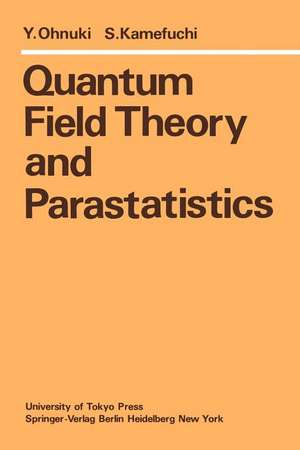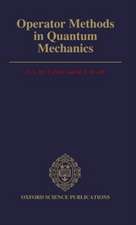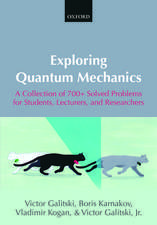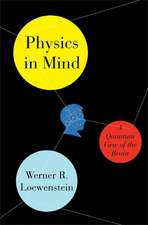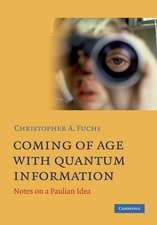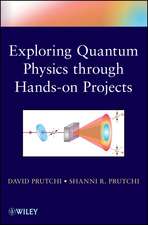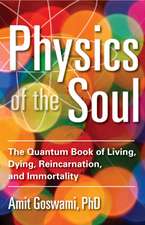Quantum Field Theory and Parastatistics
Autor Y. Ohnuki, S. Kamefuchien Limba Engleză Paperback – 6 dec 2011
Preț: 649.54 lei
Preț vechi: 764.17 lei
-15% Nou
Puncte Express: 974
Preț estimativ în valută:
124.30€ • 134.98$ • 104.42£
124.30€ • 134.98$ • 104.42£
Carte tipărită la comandă
Livrare economică 23 aprilie-07 mai
Preluare comenzi: 021 569.72.76
Specificații
ISBN-13: 9783642686245
ISBN-10: 3642686249
Pagini: 508
Ilustrații: XIV, 490 p.
Dimensiuni: 152 x 229 x 27 mm
Greutate: 0.67 kg
Ediția:Softcover reprint of the original 1st ed. 1982
Editura: Springer Berlin, Heidelberg
Colecția Springer
Locul publicării:Berlin, Heidelberg, Germany
ISBN-10: 3642686249
Pagini: 508
Ilustrații: XIV, 490 p.
Dimensiuni: 152 x 229 x 27 mm
Greutate: 0.67 kg
Ediția:Softcover reprint of the original 1st ed. 1982
Editura: Springer Berlin, Heidelberg
Colecția Springer
Locul publicării:Berlin, Heidelberg, Germany
Public țintă
ResearchDescriere
In examining the problem of quantization it is customary to proceed by following the order of historical developments, i. e. , to start with the so-called first quantization and then go on to second, or field, quantization. As is well known, the former consists in setting up commutation relations among the canonical variables (of finite degrees of freedom) which are defined originally in classical mechanics, and the latter consists in doing the same among field variables. In our opinion, however, the above order does not necessarily reflect that of physical importance. In fact, a close look at the theoretical that the latter plays a more fundamental role structure immediately reveals than the former in various respects. First, the former can be derived from the latter, and second, the assumptions that have to be made in the former, e. g. the spin-statistics connection, can be justified in the latter on the basis of its own theory. Furthermore, as the history of the positron theory shows, if we remain within the framework of the first-quantized formalism, it will no longer be possible to have a closed theory in the relativistic region where the problem becomes essentially that of an infinite number of particles.
Cuprins
I. Paraquantization.- 1. Canonical Quantization and Its Generalization.- 2. The Case of a Simple Harmonic Oscillator.- 2.1 A bose-like oscillator.- 2.2 A fermi-like oscillator.- 3. The Case of More than One Oscillator.- 3.1 Preliminaries of a generalization.- 3.2 Introduction of the groups SO(2f) and Sp(2f, R).- 3.3 Parafermi quantization.- 3.4 Parabose quantization.- 4. The Order of Paraquantization.- 4.1 State-vector space with the unique vacuum.- 4.2 The order p and irreducibility of the ring.- 5. Realization of the Paracommutation Relations.- 5.1 Commutation relations specific to given order p.- 5.2 The Green representation.- 6. General Algebraic Relations.- 6.1 The relation between two kinds of brackets.- 6.2 The decomposition theorem.- 6.3 Identities specific to given order p.- References.- II. Non-Relativistic Field Theory the case of a single parafield.- 7. Quantization of a de Broglie Field.- 7.1 Basic requirements for field quantization.- 7.2 Application of the paracommutation relations to field operators; parastatistics.- 8. Properties of State Vectors.- 8.1 State vectors of the standard form.- 8.2 Particle and place permutations; the symmetric group.- 8.3 Decomposition into Sn-irreducible subspaces.- 8.4 Proof of the main theorem.- 9. The Structure of Observables.- 9.1 The locality condition.- 9.2 Possible forms of observables.- 10. Gauge Groups.- 10.1 Klein transformations.- 10.2 Group-theoretical properties of state vectors.- 10.3 State vectors as representations of the gauge groups.- 10.4 Superselection operators.- 11. The Relation to an Ordinary Field with a Hidden Variable.- 11.1 Strong and weak equivalences.- 11.2 Local equivalence and cluster property.- References.- III. Non-Relativistic Field Theory the case of coexisting parafields.- 12. Commutation Relations between Different Parafields.- 12.1 Bilinear and trilinear commutation relations between two different parafields.- 12.2 Trilinear commutation relations between three different parafields.- 12.3 General properties of commutation relations.- 13. Generalization of the Decomposition- and Related Theorems.- 13.1 Preliminaries; generalized particle permutations.- 13.2 Generalization of various theorems and lemmata.- 13.3 Remarks on the transformation properties of inner products.- 14. Families and Gauge Groups.- 14.1 The spaces A and B of a family of order p.- 14.2 Observables and gauge groups.- 14.3 Exceptional cases of gauge groups.- 14.4 Redefinition of parafields and families.- 15. The Overall Structure of Observables.- 15.1 Nonlocal factors in observables.- 15.2 Introduction of an alternative set of Klein operators.- 15.3 The normal and anomalous cases of commutation relations.- 16. Bound States.- 16.1 Formulation in the space B.- 16.2 Statistics of bound states.- 16.3 Factorizability.- 17. Superselection Rules.- 17.1 Locality and conservation laws.- 17.2 Selection rules characteristic of parafields.- References.- IV. Relativistic Field Theory.- 18. Relativization.- 18.1 Relativistic fields; the spin-statistics theorem.- 18.2 Remarks on theories with the locality condition of the weak form.- 19. Relativistic Parafermi Fields of Order 2.- 19.1 Approach (I) with use of redefined observables.- 19.2 Approach (II) with use only of bilocal operators.- 20. Discrete Transformations in Space-Time.- 20.1 The CPT -transformation for ordinary fields.- 20.2 The CPT -transformation for parafields.- 20.3 The transformations P, C and T.- 21. The Variational Principle.- 21.1 The general procedure.- 21.2 Application to some simple systems.- 21.3 The structure of Lagrangians and the locality condition.- 22. Application to Particle Physics.- 22.1 Statistical types of fundamental particles.- 22.2 Leptons.- 22.3 Hadrons.- 22.4 Families of fundamental particles.- References.- V. Miscellaneous Problems.- 23. The Wave-Mechanical Representation for a Bose-Like Oscillator.- 23.1 The expression for the momentum operator.- 23.2 The eigenvalue problem of the momentum operator.- 23.3 The eigenvalue problem of the Hamiltonian.- 23.4 The relation between the two classes of eigenfunctions.- 23.5 The relations between ?n?’s and ?n’ s.- 23.6 The uncertainty relation.- 24. The Method of h-polynomials.- 24.1 The definition of h-polynomials.- 24.2 The relation between h-polynomials and dotted brackets.- 25. First-Quantized Formalism of Identical Particles.- 25.1 Identical particles without internal degrees of freedom.- 25.2 General formulas for the case of paraparticles.- 25.3 The case G = U(p).- 25.4 The cases G = O(p), SO(p).- 25.5 Remarks on further problems.- 26. Fermi-Bose Similarity.- 26.1 Lie-algebraic structure of parafield operators.- 26.2 A system of parafields transformable to one another.- 26.3 Families of parafields.- 27. Paragrassmann Algebras and Parafermi Systems.- 27.1 Paragrassmann algebras.- 27.2 Applications to parafermi systems.- References.- Appendices.- Appendix B. A Self-Contained Set of Commutation Relations for p =3.- Appendix D. Proof of (8.64).- Appendix E. The Decomposition U(p) ? O(p).- Appendix F. The Normal and Anomalous Cases of Commutation Relations in Ordinary Field Theory.- Appendix G. A Formal Generalization of Lie Algebras and Lie Groups.- Appendix H. Generalized Grassmann Numbers.- Appendix I. Generalized Bose Numbers.- References.- Further References.- List of Special Symbols.
